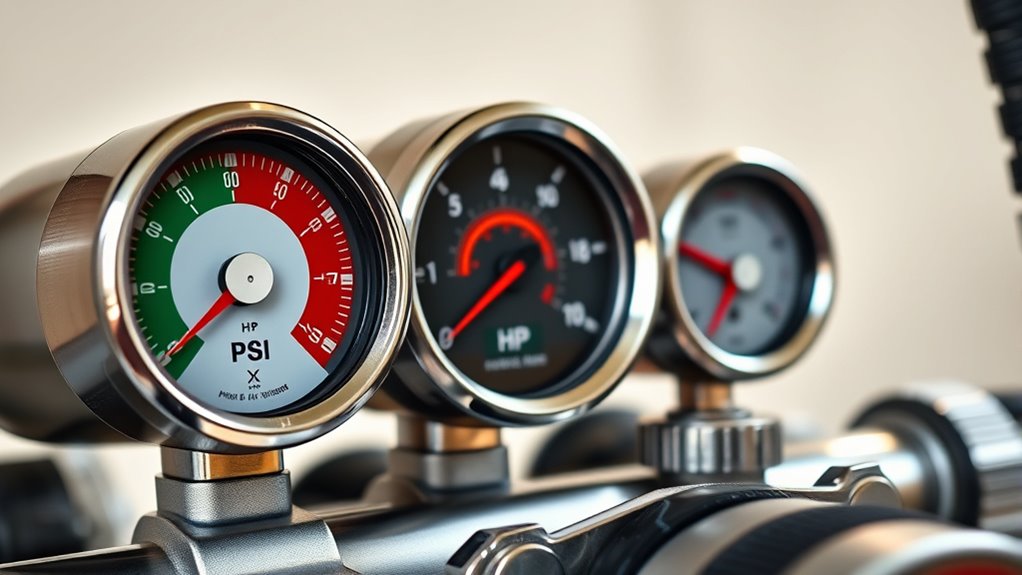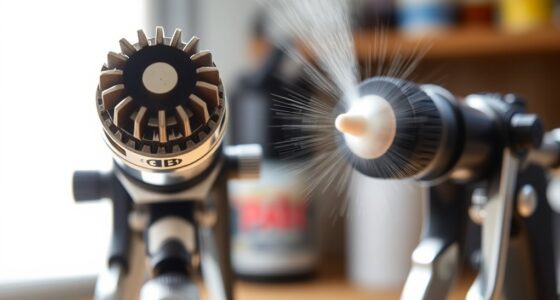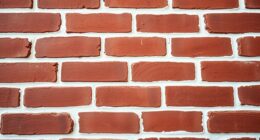Understanding airless sprayer specs like PSI, GPM, and horsepower helps you pick the right model for your project. Higher PSI means a finer finish, while GPM affects how fast you can work. Horsepower influences the sprayer’s power and durability. Matching these specs to your surface type and project size guarantees smooth results and efficiency. Keep exploring, and you’ll discover how to choose a sprayer that balances performance and longevity.
Key Takeaways
- Understand PSI for controlling spray smoothness and project suitability; higher PSI equals finer finishes.
- GPM determines paint flow rate, balancing speed and overspray for project size and paint viscosity.
- Horsepower influences pump power, with higher HP suitable for larger, demanding projects and prolonged use.
- Match sprayer specs to surface type, coating thickness, and project scope to optimize performance and finish quality.
- Consider ergonomics, durability, and safety features alongside specs to select a reliable, efficient airless sprayer.
What Is PSI and Why It Matters
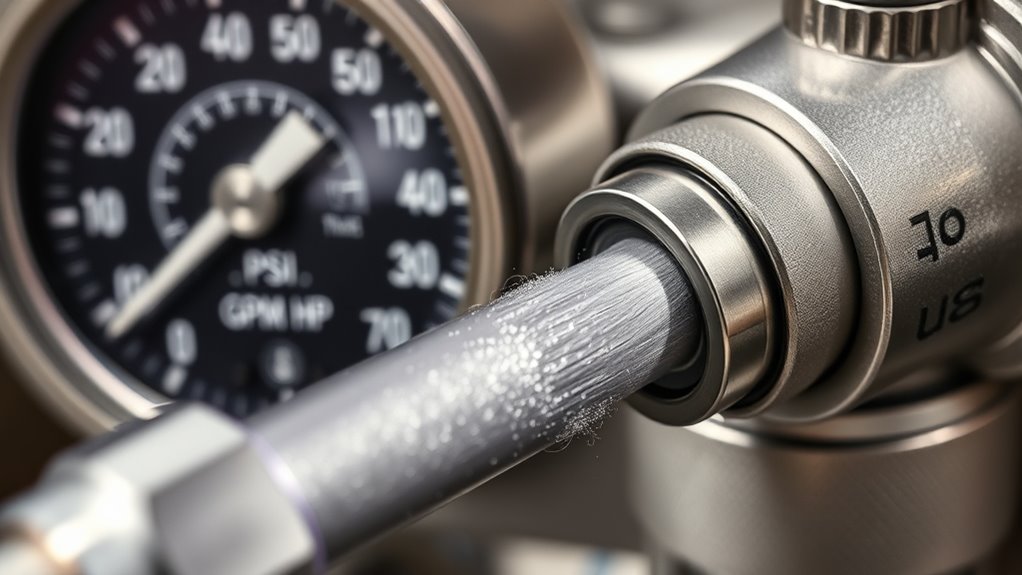
PSI, or pounds per square inch, measures the pressure your airless sprayer generates. This pressure directly impacts the paint texture you achieve—higher PSI produces a finer spray, ideal for smooth finishes, while lower PSI can result in a more textured look. Understanding PSI helps you select the right settings to match your project’s needs. It also plays a key role in sprayer maintenance; excessive pressure can strain components, leading to wear or damage. Properly managing PSI guarantees your sprayer runs efficiently and lasts longer. When choosing your sprayer, consider the PSI range that suits your typical projects. Adjusting PSI correctly not only improves your paint texture but also minimizes maintenance issues, keeping your equipment in top shape. Additionally, knowing the digital literacy aspects of sprayer operation can help users troubleshoot and optimize performance more effectively.
Understanding GPM and Its Impact on Painting Speed
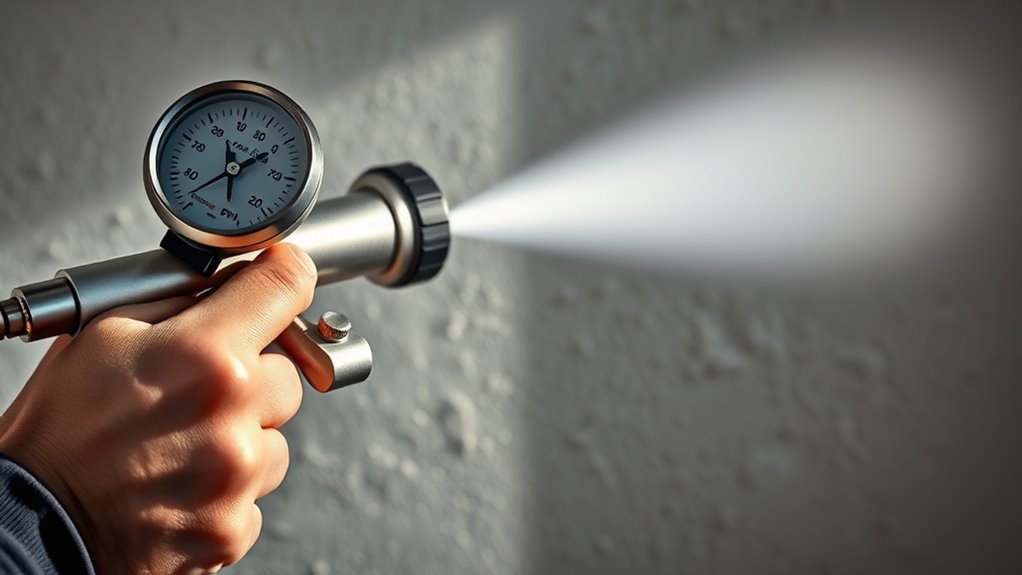
Understanding GPM, or gallons per minute, is essential because it directly influences how quickly you can complete a painting project. Higher GPM means more paint is delivered each minute, boosting your productivity. However, to maintain peak performance, you need proper sprayer maintenance, ensuring parts stay clean and functioning smoothly. Additionally, GPM impacts paint compatibility; thicker paints may require a sprayer with a higher GPM to flow properly. Choosing the right GPM depends on your project size and the type of surface you’re painting. If GPM is too low, your work slows down, but if it’s too high without suitable paint, you risk overspray or clogged nozzles. Balancing GPM with sprayer maintenance and paint type ensures efficient, consistent results. Proper adjustments to GPM settings can also help minimize overspray and improve overall finish quality.
The Role of Horsepower in Airless Sprayers
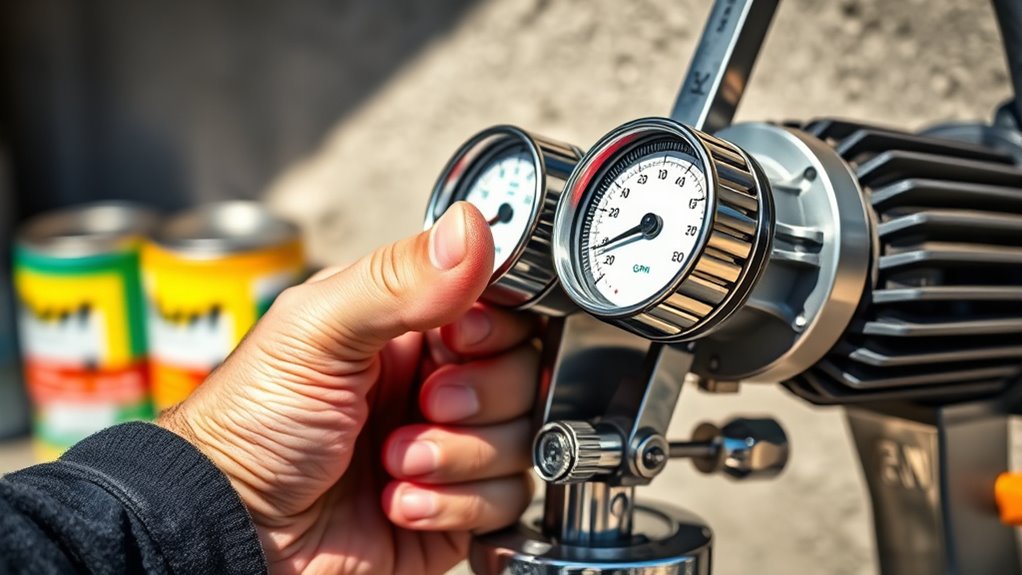
Horsepower plays a crucial role in determining how effectively an airless sprayer operates, as it directly affects the motor’s power to pump paint at high pressures. Higher horsepower generally means better horsepower efficiency, allowing you to cover larger areas faster. It also contributes to motor durability, helping the sprayer withstand prolonged use without overheating or breaking down. Additionally, understanding organization and space maximization can help you set up your workspace efficiently for using your sprayer. Here’s a quick comparison:
| Horsepower Range | Suitable For |
|---|---|
| ½ – 1 HP | Small projects and DIY tasks |
| 1 – 1½ HP | Medium-sized jobs |
| 1½+ HP | Commercial or large-scale jobs |
Choosing the right horsepower depends on your project size and frequency of use, ensuring optimal performance and longevity.
How to Match Sprayer Specs to Different Projects
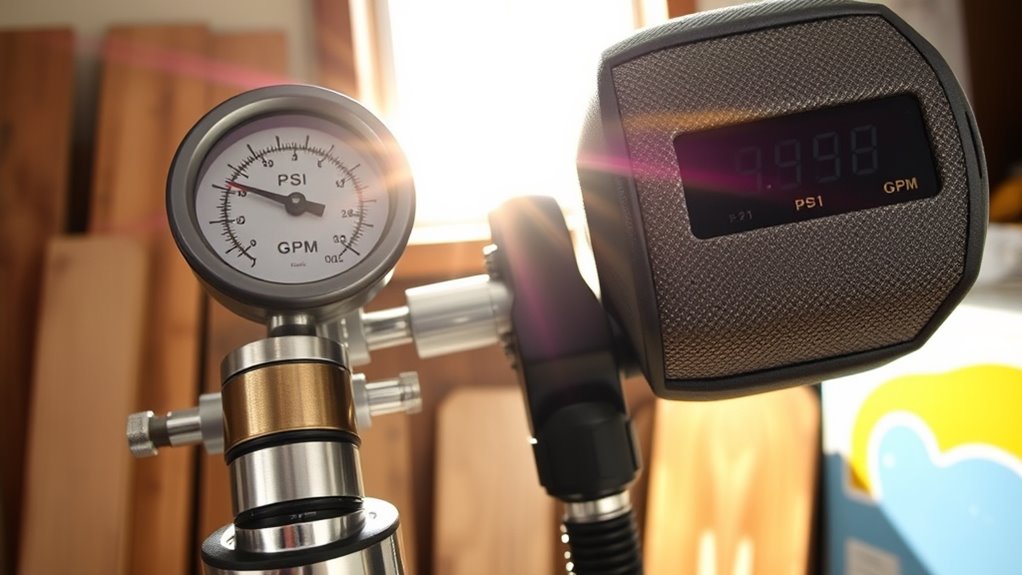
Matching your airless sprayer’s specifications to your project guarantees efficient and effective results. Start by considering the size and scope of your project—larger jobs need higher GPM and PSI to cover surfaces quickly, but ensure your equipment matches the paint’s viscosity for compatibility. For example, thick paints require sprayers with higher pressure, while lighter coatings need less. Regular sprayer maintenance is essential to keep your equipment performing at its best and prevent issues like clogging. Always verify paint compatibility with your sprayer’s specs to avoid damage or poor finish quality. Choosing the right combination of PSI, GPM, and HP based on your project’s needs ensures smooth operation, quality results, and less downtime. Proper matching reduces frustration and helps you complete projects efficiently. Additionally, using the appropriate filtering and pump protection accessories can extend the lifespan of your spray equipment and ensure consistent performance.
The Relationship Between PSI, GPM, and Finish Quality
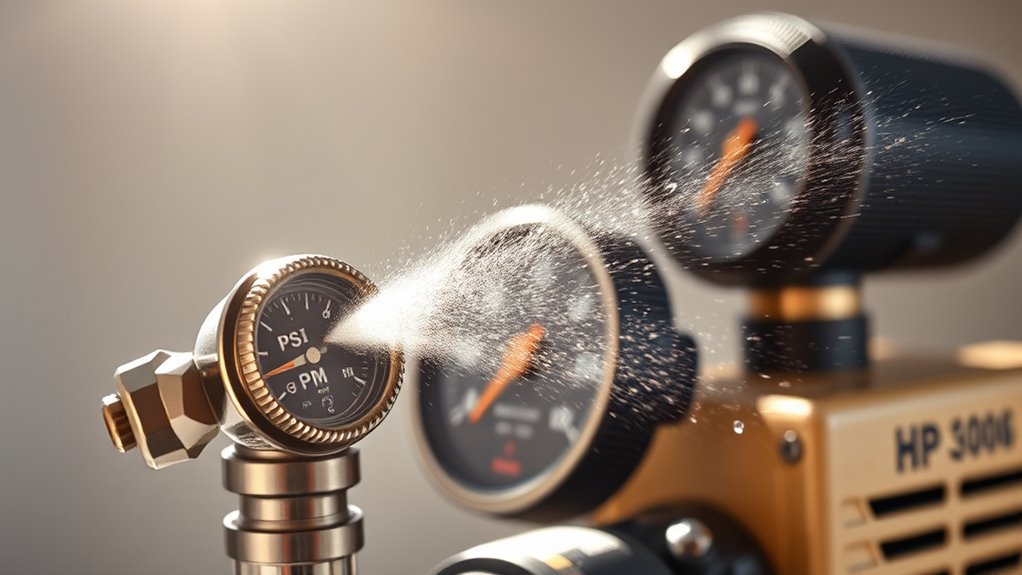
The interplay between PSI, GPM, and finish quality directly impacts the outcome of your painting project. Higher PSI increases spray velocity, helping you achieve a smoother, more even coat, but too much can cause overspray or uneven textures. GPM controls how fast paint flows; a higher GPM can improve coverage but might lead to runs if not managed properly. To get the best finish, focus on proper sprayer maintenance to keep these settings balanced, ensuring consistent spray patterns. Also, consider paint compatibility—using the right pressure and flow for your paint type prevents issues like clumping or poor adhesion. Additionally, understanding the pressure settings and their effect on different surfaces can help you tailor your approach for optimal results. When these factors align, you’ll produce a professional-looking finish, making your project efficient and satisfying.
Choosing the Right Sprayer for Small vs. Large Jobs

Choosing the right sprayer depends on the size of your project. For small jobs like furniture or touch-ups, a lightweight, handheld paint sprayer with lower PSI and GPM is ideal. These models are easier to maneuver and require less paint flow. For larger projects, such as exterior walls or extensive surfaces, opt for a professional-grade airless sprayer with higher PSI and GPM to guarantee even coverage and efficiency. Remember, proper paint sprayer maintenance is essential regardless of size, helping to prevent clogs and maintain performance. Additionally, always follow safety precautions, like wearing protective gear and working in well-ventilated areas, to protect yourself during operation. Choosing the right sprayer tailored to your project size saves time and ensures a quality finish. Understanding airless sprayer specs like PSI, GPM, and HP can help you select the most suitable model for your needs.
Common Mistakes When Interpreting Specs

Misunderstanding sprayer specifications can lead to poor performance or project setbacks. Many buyers focus solely on PSI, GPM, or HP without considering how specs relate to your specific needs. For example, higher PSI isn’t always better; it might mean less control or a heavier, less ergonomic design. Similarly, GPM affects application speed but doesn’t account for color options or ease of use.
| Specification | Common Mistake | Correct Focus |
|---|---|---|
| PSI | Assuming higher PSI equals better results | Match PSI to project needs |
| GPM | Overlooking spray pattern and ergonomics | Consider how GPM impacts control |
| HP | Ignoring overall machine design | Prioritize ergonomic design |
| Color options | Neglecting aesthetic preferences | Choose suitable color options for visibility |
| Ergonomic design | Underestimating comfort | Select models with ergonomic features |
Tips for Comparing Different Airless Sprayer Models
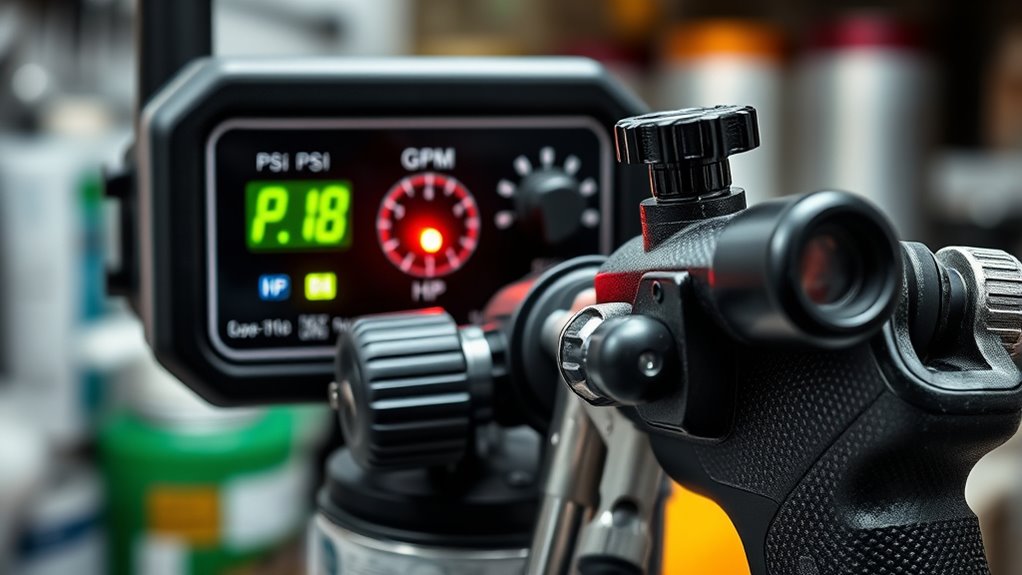
When comparing airless sprayer models, start by identifying your performance needs to make certain the right fit. Make sure to match the PSI and GPM specs to the scale of your projects for efficient results. Also, consider the power source and portability to ensure the sprayer suits your workspace and mobility requirements. Additionally, understanding tuning options available for related vehicles can provide insights into optimizing performance and efficiency in various applications.
Identify Performance Needs
To effectively compare different airless sprayer models, you need to clearly identify your specific performance needs. Think about the types of projects you’ll tackle—large surfaces or detailed work—since this influences required PSI and GPM. Consider the materials you’ll spray, as thicker coatings may need higher pressure, while delicate finishes require lower settings. Your decision should also factor in ease of use, including sprayer maintenance, to ensure longevity and consistent performance. Additionally, prioritize safety precautions by selecting a model with proper safety features. Knowing your project scope helps you focus on the right specs, saving time and avoiding overspending. By understanding your needs, you can confidently pick a sprayer that balances power, efficiency, and safety. Recognizing system efficiency can also help you choose models that operate more reliably and cost-effectively over time.
Match PSI and GPM
Matching PSI and GPM is essential when comparing airless sprayer models because these specs directly influence your project’s efficiency and finish quality. Higher PSI delivers better penetration, ideal for thick coatings, while GPM determines how fast you complete a job. To choose the right balance, consider the material and surface you’re working on. Proper sprayer maintenance ensures consistent performance and reduces safety hazards, so regularly clean and inspect your equipment. When comparing models, keep safety precautions in mind: higher pressure increases risk, so select a sprayer with manageable PSI and GPM for your skill level. Matching these specs helps prevent overspray, saves time, and ensures a smooth, durable finish. Always prioritize safety to avoid accidents during operation. Additionally, understanding the airless sprayer features can help you select the most suitable model for your specific needs.
Consider Power and Portability
Considering power and portability is crucial when comparing airless sprayer models because these factors directly impact your ease of use and job efficiency. Sprayer ergonomics plays a key role; a comfortable grip and lightweight design reduce fatigue during extended projects. Portability ensures you can easily move the sprayer around, especially on larger or multi-story jobs. Noise levels matter too—lower noise makes the work environment more comfortable and less disruptive. Assess the sprayer’s power to match your project needs, but don’t overlook how manageable it feels to operate. A well-balanced, ergonomic sprayer with appropriate power and low noise levels will make your work smoother, faster, and more comfortable, helping you finish projects with less strain and greater precision. Additionally, understanding how sound levels influence the overall working experience can help you choose a model that minimizes discomfort during prolonged use.
How to Ensure You Select a Durable and Efficient Sprayer
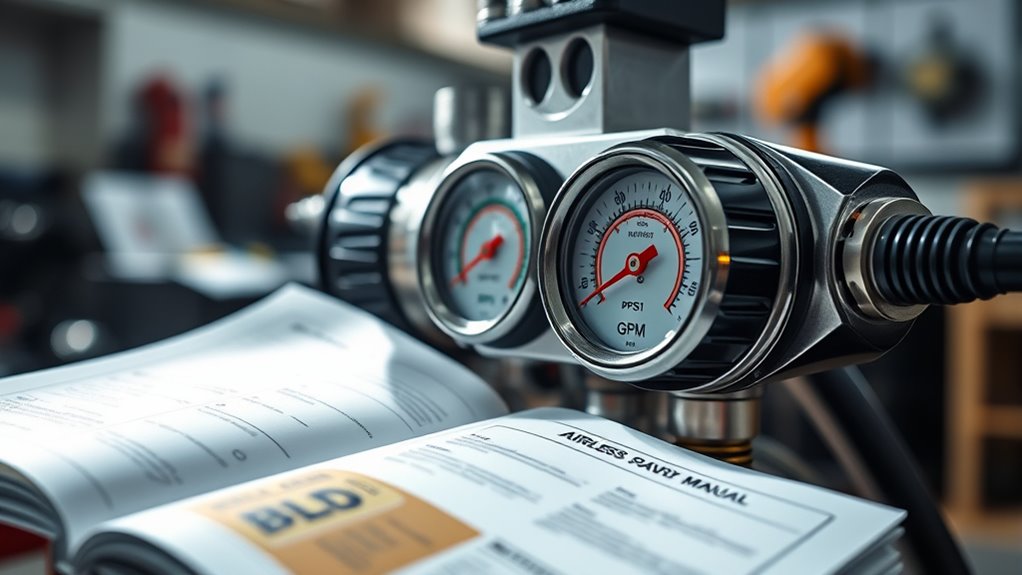
Choosing a durable and efficient airless sprayer involves paying close attention to its build quality and performance features. Look for models with sturdy construction, quality materials, and reliable components. Regular sprayer maintenance helps keep it running smoothly and extends its lifespan, so choose a model that’s easy to clean and service. Reading customer reviews provides valuable insight into long-term reliability and performance; satisfied users often highlight durability and efficiency. Consider features like corrosion-resistant parts and robust motors, which signal a longer-lasting unit. Avoid cheap, poorly made options that may break down quickly. By focusing on build quality, maintenance ease, and feedback from other users, you ensure your investment results in a sprayer that performs efficiently over time.
Frequently Asked Questions
How Does Nozzle Size Influence Sprayer Performance?
Your nozzle size directly affects spray pattern and performance. A smaller nozzle produces a finer spray, ideal for detailed work, while a larger nozzle creates a broader spray for covering large surfaces quickly. Choosing the right nozzle size guarantees you get the desired spray pattern and efficiency, preventing overspray or uneven coverage. Adjusting nozzle size helps you control the flow rate and finish, making your spraying task more precise and effective.
Can I Upgrade an Airless Sprayer’s Specs Later?
You can upgrade an airless sprayer’s specs later, but it’s essential to consider sprayer durability and maintenance requirements. Upgrading components like nozzles or pumps can improve performance, but ensure your sprayer can handle these changes without compromising its longevity. Regular maintenance helps prevent breakdowns, and choosing compatible parts preserves durability. Keep in mind, some upgrades might require professional assistance to avoid damaging your equipment or voiding warranties.
What Safety Features Should I Look for in a Sprayer?
When choosing a sprayer, you should look for safety features that meet safety standards, including automatic shut-off valves and pressure relief systems. Always wear protective gear like goggles, gloves, and masks to stay safe. These features help prevent accidents and protect you during operation. Prioritizing safety guarantees you work efficiently and avoid injuries, making your spraying tasks safer and more manageable.
How Does Weather Affect Sprayer Operation and Specs?
Weather impact profoundly affects how you operate your sprayer. High humidity, rain, or extreme cold can hinder spray quality and cause equipment issues. Wind can cause overspray, wasting material and creating safety concerns. You should consider environmental conditions and adapt your usage accordingly. Always check weather forecasts, avoid spraying in harsh conditions, and consider environmental considerations to guarantee safe, efficient, and effective spraying.
Are There Eco-Friendly or Low-Voc Options Based on Specs?
Thinking about greener gear? You’ll find eco-friendly coatings and low VOC paints come with sprayers designed for less environmental impact. Look for models with lower pressure settings and efficient flow rates that minimize fumes and waste. By choosing sprayers with eco-conscious specs, you protect your project and planet, promoting greener, cleaner finishes. So, select sprayers that support sustainability without sacrificing spray power or precision.
Conclusion
Understanding airless sprayer specs can boost your painting efficiency and quality. Did you know that choosing the right model can cut your project time by up to 30%? By mastering PSI, GPM, and HP, you’ll make smarter decisions and avoid costly mistakes. So, take the time to compare specs carefully. Your perfect sprayer is out there, ready to help you finish faster, smoother, and with professional results every time.
